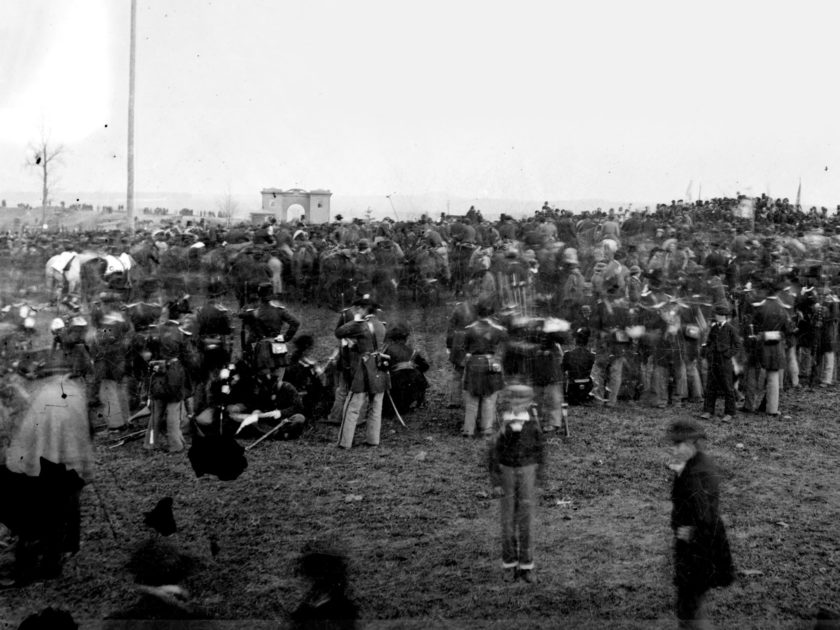It was summer when they fell, dying in the searing heat and drenching humidity of an unforgiving early July—scattered amid fields of wheat, groves of peach trees, round-topped hills, and in a ravine so encrusted with sharp rocks that it was named for the Devil himself. The piles of dead littered even the local cemetery, as if thoughtfully stacked there for internment near the gravestones of those who had perished in their beds in more peaceful times.
By the time Robert E. Lee’s battered army withdrew from Gettysburg on July 4, 1863, 7,508 men, Union and Confederate alike, lay dead across this sprawling battlefield, their bodies corrupting as the temperatures soared, burial parties unable to keep up with what seemed like regiments of lifeless soldiers. The luckier survivors included 33,264 wounded. More than 10,000 men simply vanished.
Civilians somehow endured the overwhelming destruction, the agonizing stink, the insatiable insects, the felled trees and dead horses, the indelible blood, and the maimed and moaning who filled homes and churches transformed into makeshift hospitals. The unspeakable remnants of carnage remained, until villagers willed themselves from shock and rallied to make the ground more sacred still by creating a national soldiers’ cemetery. But not before the photographers descended on this palette of death to record the unavoidable: the bodies, swollen, hollow-eyed, some faces expressionless, some frozen in a timeless scream; and the wounded who would never forget the holocaust they had somehow endured.
Not until the middle of November did the town summon a famous old orator to recite his lengthy and tedious blessing at the consecration. The same municipal fathers at least had the sense to invite the President of the United States, albeit as an afterthought. “The world will little note, nor long remember what we say here,” Abraham Lincoln declared at Gettysburg that day, Nov. 19, 1863 (so wrong about his own speech), “but it can never forget what they did here.” A man who appreciated images as well as words, he had doubtless seen the photographs of the casualties himself—of the “brave men, living and dead, who struggled here,” for such pictures both tormented him and inspirited his message of renewal.
“[F]rom these honored dead,” he pledged, “we take increased devotion for that cause for which they here gave the last full measure of devotion.” And so the mass death became a “new birth of freedom.” Only the pictures remained, haunting our national memory, and triggering the optimism that Lincoln absorbed from their sacrifice.
—Harold Holzer

Captain Clark and the Unexpected Recruit
As Capt. Erastus L. Clark and the 12th Massachusetts Infantry made their way through the Maryland countryside, headed toward Gettysburg on June 30, 1863, a curious event occurred. A sergeant, so the story goes, encountered a slender lad near a watering hole. The sergeant told the inquiring youth that a great battle was imminent. The boy’s eyes “glowed with enthusiasm, and he expressed a wish to join the army at once, ‘and fight the rebels.’” The sergeant brought him to Clark. “Captain, here’s a recruit for you.” Clark was impressed and presented the lad to the commanding colonel, who told Clark, “Well, captain, you may take him into your company if you wish, but we cannot muster him in now, as the books are back with the teams.”
The 12th went into battle the next day and suffered heavy losses, including Clark. A shell wound in the face ended his combat service. He then joined the Veteran Reserve Corps. In 1867, he became a Freedman’s Bureau agent and purchased a stake in a Louisiana plantation. A dispute with his partner was settled on July 17, 1867, by a brutal duel with pocketknives. Clark lost.
The lad, Charles F. Weakley, suffered wounds in the right arm and thigh, and was left behind during the retreat through Gettysburg. He made it back to Union lines, recovered and enlisted in the 13th Pennsylvania Cavalry. He drowned on Dec. 18, 1864, after an epileptic seizure.
Wounded in a Legendary Charge
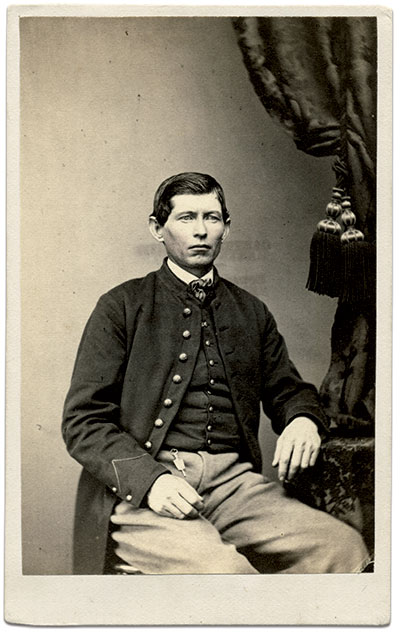
Maj. Gen. Winfield Scott Hancock likely understood that he was sending Cpl. Ernst L.F. Miller and his comrades in the 1st Minnesota Infantry to their deaths when he ordered the regiment into action on July 1. The troops were urgently needed to slow the Confederate advance against the key Union defenses on the heights of Cemetery Ridge. The Minnesotans, numbering eight companies and commanded by Col. William Colvill, instantly obeyed and successfully charged an enemy five times their number. Casualties in the 1st were catastrophic—82 percent of the men were killed or wounded, including Miller. A German immigrant who had worked as a sawyer in St. Paul, Miller suffered a bullet wound in his right thigh, just above the knee. Moved to several hospitals on the battlefield, he was eventually transferred to Philadelphia, where he sat for this portrait. Miller made a full recovery and left the army with a disability discharge in the summer of 1864. He returned to Minnesota, married and started a family. He died in 1883 at about age 50.
Years later at a memorial dedication, President Calvin Coolidge remarked, “Colonel Colvill and those eight companies of the First Minnesota are entitled to rank as the saviors of their country.”

“I am Going Home”
The clash of the 26th North Carolina and 24th Michigan along McPherson’s Ridge on July 1 ended in success for the Confederates. Victory came at a high price for the Old North State boys—647 of 843 were casualties, including William R. Payne. A private in Company I, he suffered a slight wound in the body. As far as battle injuries are considered, he might be described as fortunate compared to many of his brothers in arms, grievously wounded and unable to move. Any luck that Payne may have had ran out two weeks later. On July 14, federal forces in pursuit of retreating Confederates captured him along the Maryland side of the Potomac River at Falling Waters. Payne and other prisoners were sent to Point Lookout, Md.
At some point after his imprisonment, he fell ill, perhaps the result of disease or his wound. He succumbed to his affliction at the camp hospital on March 15, 1864. He was about 22. A fellow prisoner described his death in a letter to Payne’s father, “He was taken very gently,” and added, “He said tell Father ‘I am going home.’”
Payne’s remains rest in Point Lookout Confederate Cemetery.
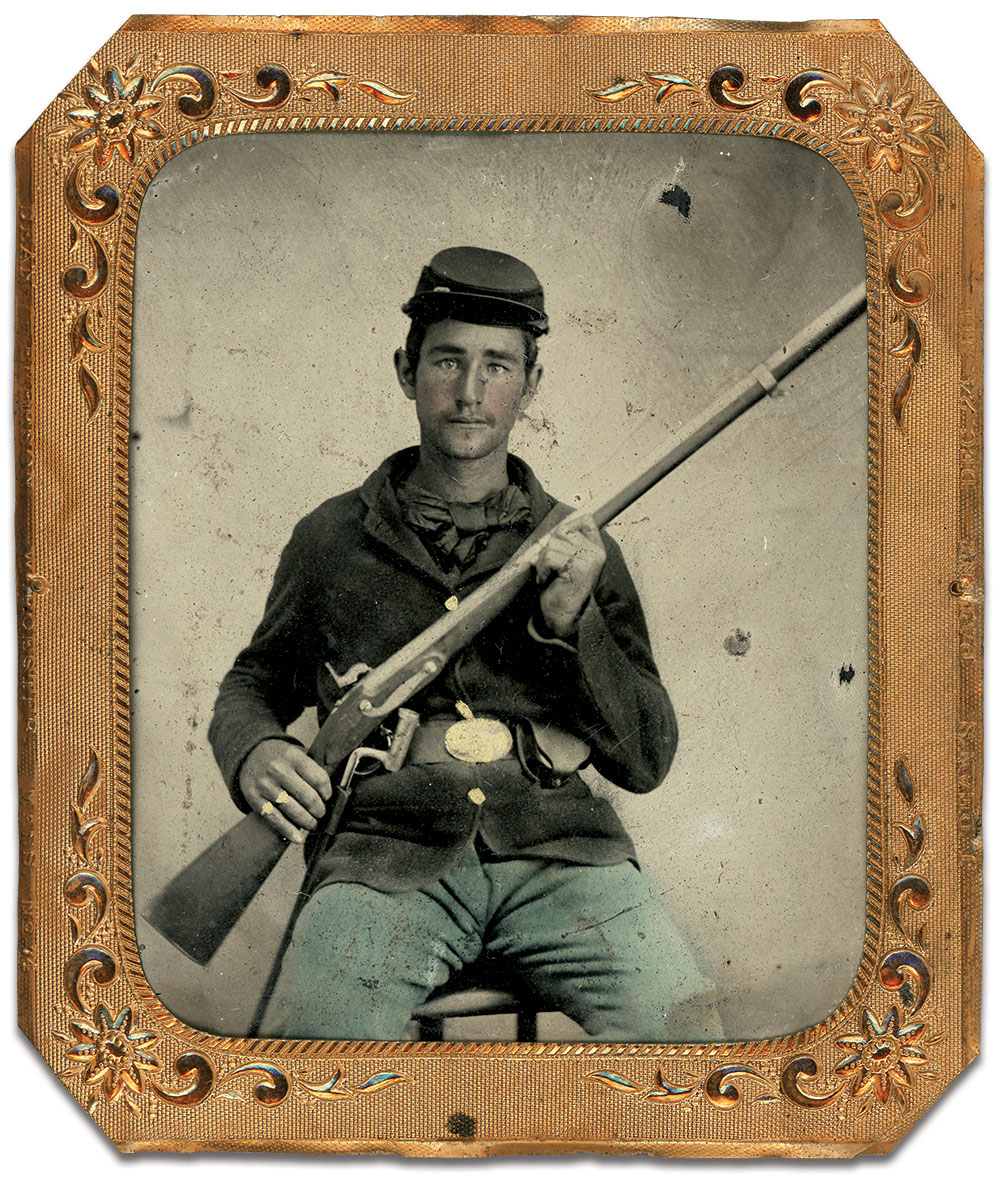
In the Maelstrom of the Wheatfield
William Dunn was flush with patriotism when he enlisted in Company F of the 62nd Pennsylvania Infantry in 1861. A lanky 19-year-old with red hair and blue eyes, and known as “Will” to family and friends, Dunn soon experienced the horrors of war.
By early 1863, Dunn confessed that he was “as tired as soldiering as any person” in a letter home. Yet, referring to another of his fellows who feigned illness to avoid duty, he wrote, “Before I play off sick to get my discharge, I will serve five years, for I think an honorable discharge is better to me than a fortune.”

These were among the last words Dunn ever wrote. On the evening of July 2, as the 62nd entered the maelstrom of the Wheatfield, Dunn was ordered to the picket line and instantly killed. A sergeant in Company G noted, “He is buried on the Battle field on the Farm of a Wm. Ros near John J. Weikert’s house. Thair is three other members of Company F buried with him.”
That autumn, artist Joseph Becker sketched the spot, located along the Millerstown Road leading to Little Round Top. The drawing, which appeared in Frank Leslie’s Illustrated Newspaper, depicts three graves. Lettering on the crude headboards indicates that the dead served in the 62nd, and one reads “Wm Dunn.” His remains were later moved to the Pennsylvania section of the Soldiers’ National Cemetery.
The Sad Saga of Henry Seas

Henry Seas Jr. was thrown into action along with the rest of his regiment, the 82nd Ohio Infantry, to stem a massive assault by Confederates on the Union left on July 1. The 312-strong 82nd had little chance against the Confederate brigades of George Doles and John B. Gordon. When the fighting ended, more than half of the regiment, 181 men and officers, were casualties, including a badly wounded Seas. An orderly sergeant in Company D, he was likely taken with other injured men to the makeshift hospital of the 11th Corps at the George Spangler Farm. The conditions were horrific—a barn on the property overflowed with wounded from both sides, and many lay outside without care. When rain began to fall on July 4, conditions worsened. One steward recalled that the incessant rains caused “foul water to ooze up into their undressed wounds.”
On July 17 after more than two weeks of suffering, Seas succumbed to his injuries. He was probably buried on the farm in one of the many dozen graves on the property. He may have been reinterred in the National Cemetery in an unmarked grave.
For Country and the Cross

About an hour before the desperate fight on Little Round Top, a first lieutenant in the 44th New York Infantry happened upon one of the boys in his company engaged in earnest prayer. He was Pvt. George B. Wolcott, a young man of strong Christian values. “George was not only a good soldier for his country, but, also, a good soldier of the Cross,” recalled the officer, Albert N. Husted.
Wolcott had a religious turn of mind since childhood. The death of his mother some time around 1860 deepened his devotion. Her last reported words to him were, “Be a good boy and meet me in heaven.”
In the summer of 1862, Wolcott and other students at the State Normal School in Albany, N.Y., shouldered muskets for the Union. Two of their professors, including Husted, joined them. They became Company E of the 44th.
Less than a year later at Gettysburg, Wolcott filed into an exposed position along Little Round Top with the rest of his regiment. In the fighting that followed, a bullet pierced his hand and struck his forehead, killing him instantly. He had said his prayers just an hour earlier. Husted recalled that Wolcott and two others were hastily interred, “We buried them side by side beneath a black walnut tree and placed a board marked with their names and the order of interment. They fought bravely and well.”
Wolcott’s remains were later reinterred to the New York section of the Gettysburg National Cemetery.

Premonition on Little Round Top
Prior to the action on Little Round Top, three captains from the 44th New York Infantry made small talk while waiting for orders to advance. One officer, Lucius Sherman Larrabee, addressed his comrades at one point with a grim prediction. “Since our last battle I have known that I would be killed the next time I was under fire,” referring to the Battle of Chancellorsville two months earlier. The other captains, William R. Bourne and Benjamin K. Kimberly, assured him that they all shared the same odds of dying this day. They refused Larrabee’s wish for them to take his watch, money and other valuables. Larrabee was not convinced, and he left his possessions in the care of the regimental quartermaster.
Soon came the order to advance. The historian of the 44th recorded what happened next: “While the line was forming on Little Round Top, he was ordered to take his Company and deploy it as skirmishers, which he promptly proceeded to do. As he left his position in line, Capt. Bourne spoke to him, wishing him good luck. He replied, ‘Good bye, Billy, I shall never see you again.’ In this unexpected order he saw the setting sun of his pure, noble life. After advancing about 200 yards, he suddenly came upon the enemy’s first line of battle, and he was killed at the first volley.” Larrabee was a just a few weeks shy of his 26th birthday.
Larrabee’s body was carried to a house behind the Round Tops, and eventually sent to his home in Chicago for burial. His loss deprived the regiment of a fine officer who had been a member of Elmer E. Ellsworth’s United States Zouave Cadets prior to the war.
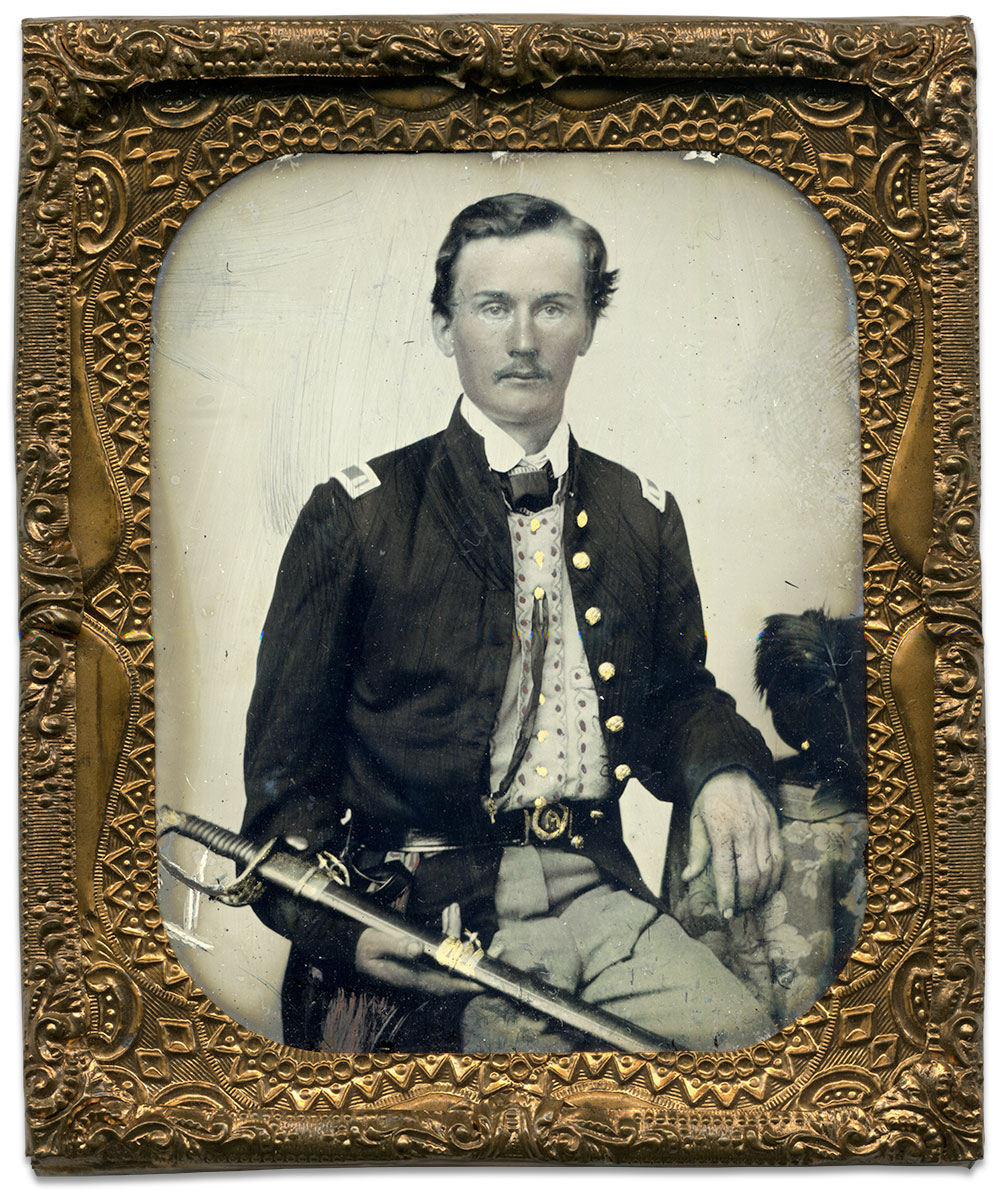
Precarious Position Behind a Great Boulder
The Confederate assault against Union forces posted along rock-strewn Houck’s Ridge on the afternoon of July 2 resulted in complete success. Among the troops who made the victorious charge was the 20th Georgia Infantry. Its ranks included Pinkney Gilliard Hatchett, known as “Pink” to his friends. Hatchett had enlisted as first lieutenant of Company E in the autumn of 1861. He had led his company in some of the war’s biggest battles up to that point, including Antietam and Fredericksburg, and emerged without serious injury. His luck changed at Gettysburg, when he suffered a disabling wound in his left ankle. Hatchett and other Georgians pursued the Yankees over Houck’s Ridge, only to realize they had missed an order to halt and had advanced too far. In this precarious position, Hatchett recalled, “We found partial shelter behind a great boulder near by and there received the disabling wound. Dreading with horror of being a prisoner in a Northern bastille took chances by retreating, crawling on hands and knees over the same ground we proudly charged a short while before.” He eventually made it safely back to his own lines.
Hatchett remained with the 20th until the autumn of 1864, which was the last time his name appeared on the regimental rolls. He later resurfaced in Texas, where he signed the oath of allegiance to the federal government in 1871. Hatchett taught school for a time, started a short-lived cattle business, and sold kerosene. He lived until age 92, dying in 1931. His wife and two sons survived him.

No One to Mourn
Most of the soldiers who perished at Gettysburg left behind family members to mourn their passing. William H. Cox appears to be one exception. A day laborer on the McElroy farm in Orange County, N.Y., before the war, he enlisted in the 124th New York Infantry in the summer of 1862. The regiment became known as the “Orange Blossoms,” a name given to them by their colorful commander, Col. A. Van Horn Ellis.
Cox began his service as a sergeant in Company H. He and his comrades suffered heavy losses in the fighting at Chancellorsville on May 3, 1863, where Cox was slightly wounded. Two months later at Gettysburg, brutal fighting decimated the regiment along Houck’s Ridge, a rise of rocky ground anchored on its southern end by an outcropping of boulders known as Devil’s Den. The regiment entered the fray with 290 officers, and men, and came out with considerably fewer. One member of the regiment noted after the battle, “We now number about one hundred and sixty-five men. It is awful. One or two more fights and it is gone.” Casualties included Cox, originally listed as wounded and missing and later presumed killed. He likely lies buried on the battlefield in an unmarked grave.
A Storm at Little Round Top
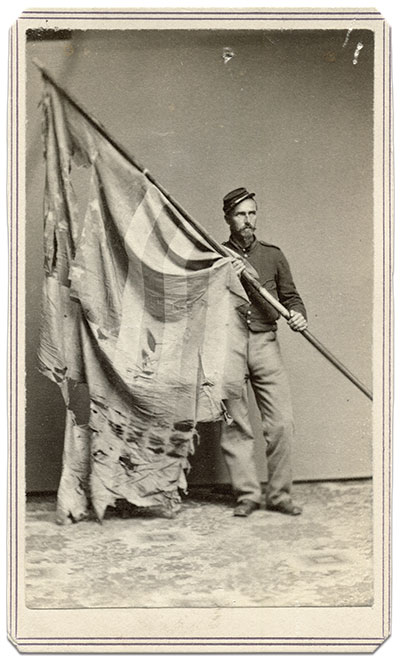
In the ranks of the 44th New York Infantry, 1st Sgt. James B. Storm and his Company A scraped together breastworks along Little Round Top. For the 29-year-old Storm, building walls was part of his peacetime profession as a bricklayer. The defenses he and his comrades constructed on the afternoon of July 2 provided scant protection however, from a massive attack by Confederates on their position. When the fighting concluded, more than a third of the New Yorkers were killed and wounded. “Firing ceased about 8 p.m., and then we went to work caring for our wounded,” noted a soldier in Company A, who added, “Our company lost more than any other company in the regiment, 22 out of 40, had 5 killed.” The list included Storm, wounded in the wrist.
Storm, who had been wounded previously at Fredericksburg, recovered, and remained in uniform until the regiment mustered out of the army in October 1864. He lived until age 64, dying in 1899. His wife and five children survived him.

“There Would Have Been None of Us Left”
Though only 90 muskets strong, the 61st New York Infantry could fairly claim title as one of the hardest fighting regiments in either army. They had survived the most severe contests of the war, including Antietam and Fredericksburg, and had been commanded by the likes of Francis C. Barlow and Nelson A. Miles.
On July 2, they were called to arms again. One man present, 21-year-old Isaac “Ike” Plumb Jr., was captain of Company A. He and his comrades marched into the hell of the Wheatfield late in the day. Rebel lead knocked them down in alarming numbers. One shot struck Plumb in the chest and sent him sprawling. Although left for dead, a silver pencil and two keys in his pocket had blunted the force of the bullet. He soon recovered, and rejoined the fight. The federals withdrew after about 30 minutes. The 61st lost 65 men—two-thirds of its number. Reflecting on the loss, Plumb wrote on July 4, “If we had remained in the fight a short time longer there would have been none of us left.”
Exactly one year later Plumb succumbed to injuries in the right leg and arm that he received at the Battle of Cold Harbor. He was 22. His remains were brought home to Sherburne, N.Y., for burial. 1st Lt. Jervis D. Cook was promoted to captain. He is shown here at Plumb’s gravesite in 1864. Cook survived the war and lived until 1898.

Alone and Forgotten on Independence Day
Late in the afternoon of July 2, the 15th Massachusetts Infantry was ordered to the Emmitsburg Road near the Codori Farm, in what would be a vain attempt stem the Confederate advance. A fight ensued, and the Bay State boys suffered heavy casualties, including George L. Boss, struck by a shell in the right thigh. Boss was taken to the Second Corps field hospital on the Jacob Schwartz property in the vicinity of Rock Creek. According to a comrade in the 15th, who had also been wounded, they found refuge on a small knoll and waited for treatment. But help never arrived. Finally, on the evening of Independence Day, Boss “worked himself down to a fire” that had built nearby in a drizzling rain, and “wrapped his blanket around him and died there.” Buried on the Schwartz property, Boss’s remains were later reinterred in the Massachusetts section of the Soldiers’ National Cemetery.
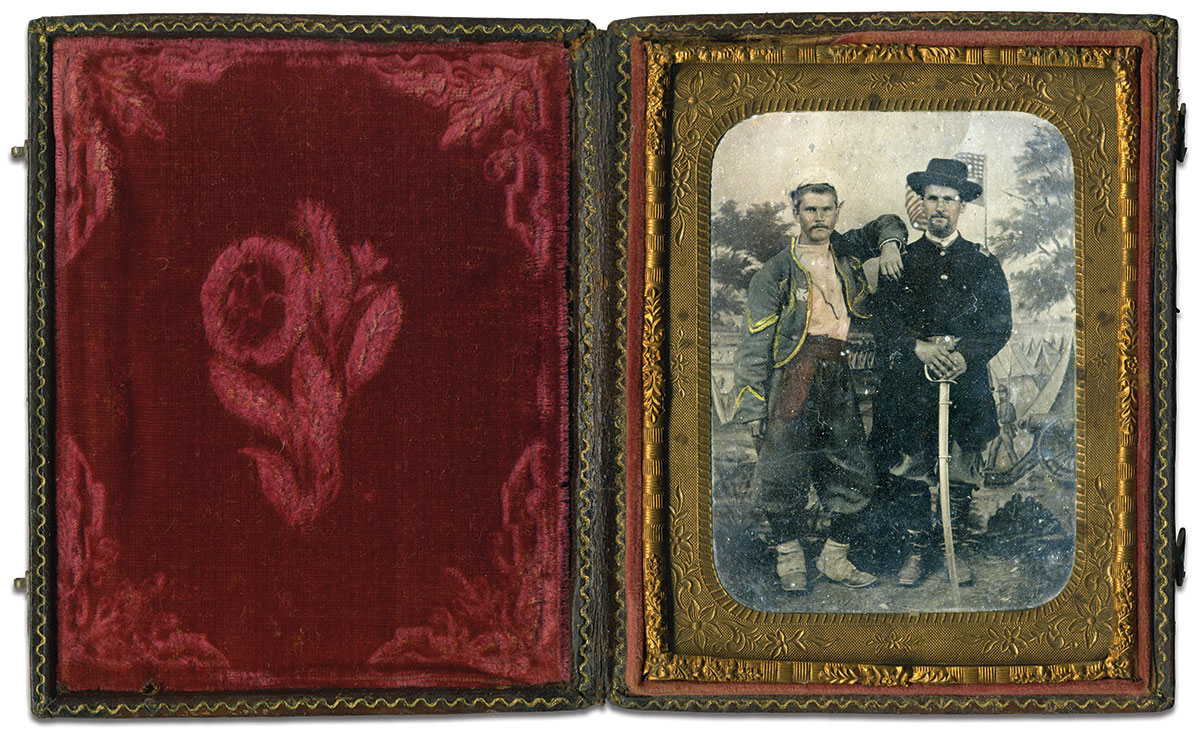
The Jones Boys Defend a Critical Sector of the Line
The 146th New York Infantry counted among the first Union regiments to occupy Little Round Top. They scrambled into position after Maj. Gen. Gouverneur K. Warren organized a defense to face oncoming Confederates during the afternoon of July 2. Conspicuous in zouave-inspired uniforms of light blue and yellow trim, a historian described the action, “What a scene was Round Top! There was the high bluff covered with rocky crags, among and on which our brave zouaves were disposed in every possible position. On the central rock was the signal flag, telling the story of the battle. And there was Warren—the master mind it seemed of the field,—with his neck patched up from the wounds received on that spot.”
The 146th included two brothers, 2nd Lt. Adelbert Jones, right, and his younger brother, Pvt. Orlo H. Jones. Both were present and did their part to defend this critical sector of the Union line. When the fighting concluded, the regiment counted 28 casualties, including Adelbert. An early report claimed he had been killed. He had, in fact, suffered a slight wound in his head. Orlo escaped unharmed.
The war ended for the Jones boys in 1864 on Virginia battlefields. Adelbert suffered a wound at Laurel Hill on May 8, and left the army with a discharge. He lived until age 82, dying in 1920. Rebel lead cost Orlo his left leg at Bethesda Church, Va., on June 2. He fell into Confederate hands and died in captivity.
Critically Wounded Sharpshooter

A brigade of Alabamians commanded by Maj. Gen. Cadmus Wilcox collided with Col. Hiram Berdan’s 1st U.S. Sharpshooters while the elite federal marksmen reconnoitered Pitzer’s Woods on the morning of July 2. An intense firefight followed, and the stubborn sharpshooters eventually pulled back. During the retreat, Cpl. William H. Leach of Berdan’s Company F suffered a grievous wound when a bullet tore through his kidneys, and a spent ball shattered several ribs. A Vermonter who had enlisted in the 1st in 1861, he was promoted to corporal shortly before Gettysburg.
Leach fell into enemy hands, and landed in the Lutheran Seminary. Confederate surgeons cared for him until the Army of Northern Virginia evacuated the area. Federals found him on July 5. Thus began a long and painful recovery in Harrisburg, Pa. Leach was discharged in early 1864, and he returned to civilian life. He died in Illinois in 1911.

Fighting Like Demons
Before dawn on July 3, a tidal wave of rebel infantry rose up from the carnage and debris around Culp’s Hill, and swept towards waiting bluecoats with a piercing yell. The federals responded with a murderous fire of cannon and musketry. “No living thing that was exposed could live,” claimed a correspondent in the 137th New York Infantry. One of the New Yorkers in the ranks that morning was Frederick A. Archibald, a private in Company C. It was a miracle of sorts that he and his comrades were still alive. Less than 12 hours earlier, they had been caught in a Confederate attack that hit them on the front, right flank and rear. They fought ferociously, and held their ground. After the fighting, they hunkered down in their entrenchments overnight.
Following a brief interlude, the Confederates resumed the attack. On the Union side, noted an officer in the 137th, “The breastworks were fully manned, and for nearly six hours the rattle of musketry was incessant. Not an instant did the firing cease, but as fast as those in the front exhausted their ammunition, fresh regiments would come rushing up, cheering and with flags flying, to relieve them.”
When it was all over, both sides counted their casualties. One of those who fell was Archibald. About 29 years old, he left behind a wife. She remained a childless widow until her death in 1914.
Archibald’s remains lie in the New York section of the Gettysburg National Cemetery.
In Support of de Triobrand’s Brigade
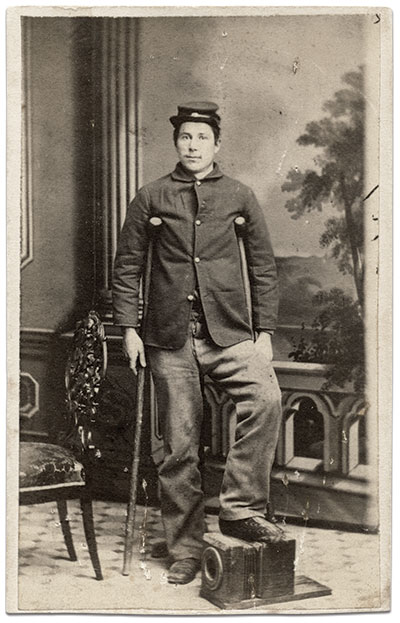
Pvt. Albert Lewis Jordan and his comrades in the 18th Massachusetts Infantry were called into action immediately at Gettysburg. The regiment marched with other forces to the vicinity of the Wheatfield, after a brother brigade, commanded by Col. Régis de Trobriand, had been flanked in spirited fighting. The Bay State boys, depleted by disease and battle deaths to a mere 139 muskets, pitched-in against the Confederates, but were speedily outflanked and forced back with 14 casualties. Among the wounded was Jordan, who suffered a gunshot wound in the left thigh and hip. The rebel lead had passed through his wallet and a picture of his newlywed wife, Clara, before it tore into his body.
Surgeons determined the wound severe, and, after treatment, sent him to the military hospital to recuperate in nearby York. He posed for this portrait, resting the foot of his injured leg on a camera, prior to March 7, 1864, when he was transferred to Lovell General Hospital in Portsmouth Grove, R.I. He left the army with a disability discharge a couple of months later, and returned to his wife and farm in Franklin, Mass. They had one child, a daughter, who survived her father after his death at age 54 in 1890.
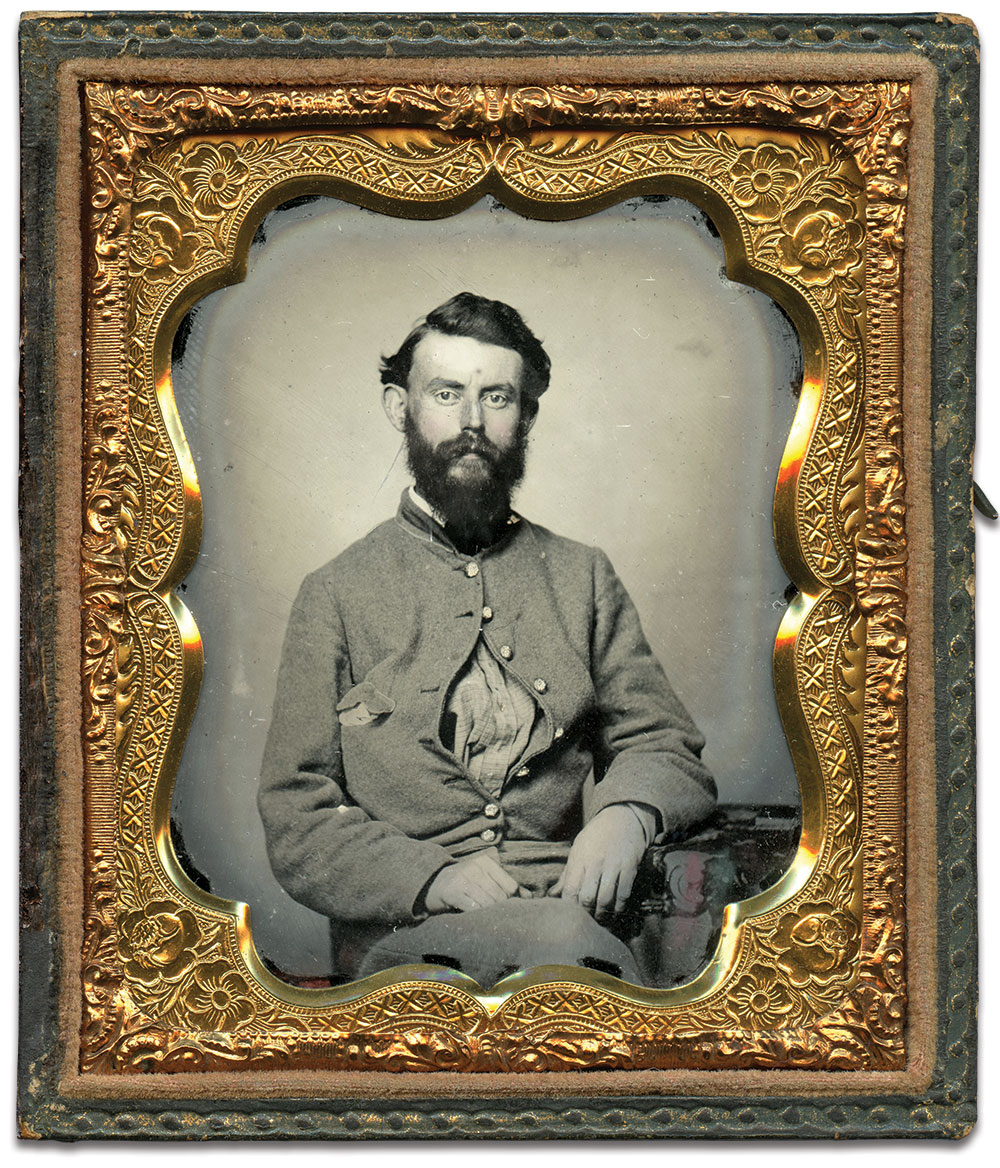
Captured a Few Feet from Where Armistead Fell
A fateful drama played out for the 9th Virginia Infantry in the midst of Pickett’s Charge. As 2nd Lt. John Vermillion, pictured here, and 1st Lt. John C. Niemeyer marched towards the federal lines with their men, a private, Mills Brinkley, made an unusual request. He turned to Niemeyer and asked to leave the ranks and go to the rear because, he believed, he was going to be killed. The premonition of death had visited Brinkley before Gettysburg, and now the sense came over him again with renewed intensity.
Niemeyer refused, and he ordered Brinkley back in line. But Vermillion intervened on the private’s behalf. He reminded Niemeyer that Brinkley was a brave soldier. Niemeyer, the ranking lieutenant, refused again, and Brinkley resumed his place. A historian recounted what happened next: Brinkley “had hardly taken twenty steps further in advance when a piece of shell struck him in the forehead, killing him instantly. In a very few minutes afterwards Lieutenant Niemeyer was himself killed.”
Vermillion’s military service ended moments later after Pickett’s Charge collapsed, when he fell into enemy hands. According to one report, he was captured just a few feet from where his brigade commander, Gen. Lewis A. Armistead, fell mortally wounded. Vermillion spent the rest of the war in prison. A native of Portsmouth, Va., he settled in Norfolk and resided there until his death in 1911. He never married. His was remembered as a gentle and generous man.

A Joyful Welcome Goes Wrong
The 149th New York Infantry and other federals held Culp’s Hill against Confederate attacks through the evening of July 2. Among those who kept the rebels at bay was Capt. James E. Doran of Company K. After fighting resumed the next morning, the men of the 149th were delighted to find that a brother regiment from their home county of Onondaga, the 122nd, had joined them. Doran made his way over to welcome the newcomers. As he waved his cap in the air, a bullet struck him in the right forearm and knocked him to the ground. The lieutenant colonel of the 149th, Charles B. Randall, went to assist Doran, and took a bullet in the shoulder as he knelt over the fallen officer. Both men eventually recovered.
Doran left the 149th in early 1864 to become a major of the 24th New York Cavalry. About this time, he posed with his horse and his son, James E. Doran II, who happened to be deaf and mute.
On March 31, 1865, during the Battle of Dinwiddie Court House, Va., Doran suffered a gunshot wound to the lungs. He succumbed to his injury on April 14, the same day John Wilkes Booth assassinated President Abraham Lincoln.
Doran’s son, his two sisters and wife survived him. Young Doran became a husband, father and post office clerk. But his life was cut short at age 52 in 1905. A train struck him in Syracuse while he was on his way to visit a sick friend.

Kemper’s Brigade Never Looked Better
It was said that Kemper’s Brigade had never looked better when it formed for Pickett’s Charge. Commanded by Gen. James L. Kemper, the brigade included the battle-hardened 24th Virginia Infantry. Among its veterans was Sgt. John Webb Helms Jr. of Company A. The son and namesake of a Floyd County sheriff and state legislator, he worked as a barkeep before his 1861 enlistment. Wounded at Second Manassas in 1862, he recovered and rejoined his company. At Gettysburg, the 24th was one of the few Southern regiments that kept its colors throughout Pickett’s Charge. Some of its men made it up and over the Union defenses—albeit for a short time. The 24th experienced heavy casualties during the advance, and more as they fell back. At some point during the fighting, Helms suffered a debilitating wound. The exact nature of his injury was not reported, but it kept him out of action the rest of the year.
Helms eventually returned to the army with the 21st Virginia Cavalry, and served with his younger brother, Tazewell, until the end of the war. He later removed to Colin County, Texas, where he died in 1887. He was unmarried.

A ‘Southern Brave’ in an Unmarked Grave
The LaPrade cousins entered Pickett’s Charge not knowing that for one of them this would be their last fight with the 14th Virginia Infantry.
In the spring of 1861, Everett G. LaPrade, right, a 22-year-old-carpenter, and 19-year-old farmer Cornelius B. LaPrade had travelled from their homes in Chesterfield County to enlist as privates in a company formed as the “Chester Grays,” or “Southern Braves.” The unit mustered into the army as Company I of the 14th, and was attached to Gen. Lewis A. Armistead’s brigade of Maj. Gen. George Pickett’s division.
The LaPrade boys were among the 422 troops that marched in the open from Seminary Ridge toward Union troops massed beyond the Emmitsburg Road on the afternoon of July 3. When it ended, 25 percent of the 14th were casualties, including Cornelius. His comrades believed he had been wounded and captured, but no federal records confirm this scenario. He was likely killed during the charge, and buried in an unmarked grave.
Everett survived the charge, and remained on the regimental rolls until the fall of 1864, when his name disappeared from company records. At some point, he returned to his family in Chesterfield County, and resumed life as a carpenter. The last time his name appeared on a government record is 1880 at age 41. At the time, he lived in Midlothian, Va., with his wife and five children. The eldest child, a 12-year-old boy, was named for his fallen cousin, Cornelius.
He “Charged Like a Thunderbolt”
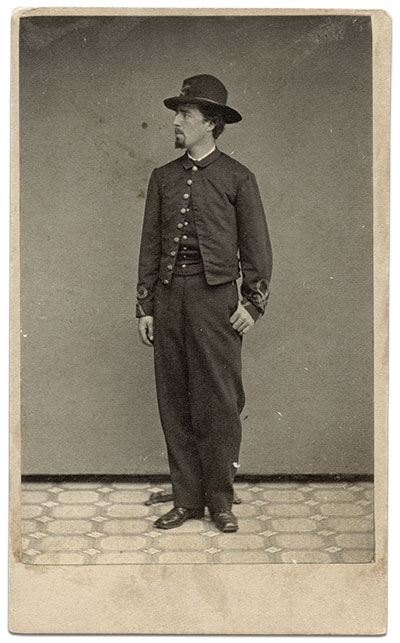
No one expected Union Capt. Walter Symonds Newhall to join in the fighting at Gettysburg. As acting adjutant general of his cavalry brigade in the Army of the Potomac, he was expected to deliver orders and stay out of harm’s way. But when rebel troopers advanced against his 3rd Pennsylvania Cavalry on July 3, Newhall could not resist. The six-foot international cricket star joined in a headlong charge against the enemy.
An admirer recorded what happened next, “Newhall had made straight for the battle-flag, and raising his sabre charged like a thunderbolt upon the color-bearer, but the latter suddenly lowered the spear-head of the banner, and struck his antagonist full on the chin with terrible force, shattering his jaw, tearing his cheek to pieces, and knocking him senseless from his horse.”
Newhall returned to his home in Philadelphia to recuperate and posed for this photo with his damaged face hidden from view. He returned to the army before the summer was out and resumed his fighting ways in small skirmishes in Virginia. On Dec. 18, 1863, as he made his way home on a leave to visit his parents for Christmas, he became hopelessly mired in mud as he attempted to cross the rain-swollen Rappahannock River on his horse and drowned. He was 22 years old.
British Blood Is Spilled

South of Culp’s Hill at McAlister’s Woods, a 674-strong regiment of Maryland men spent the morning of July 2 constructing breastworks. They were the Union-loyal 1st Maryland Infantry of the Potomac Home Brigade. Their number included an English immigrant, Roger Q. Bellis, the eldest son of a tailor. Forced to evacuate his Annapolis home after rebel forces threatened the town in the spring of 1861, Bellis relocated to the Baltimore area, and enlisted in the 1st as a sergeant in Company D. Two years later at Gettysburg, the 1st and the rest of the division were ordered away from the freshly dug entrenchments to support federals under heavy attack by Lt. Gen. James Longstreet’s Confederates.
The Marylanders later returned to Culp’s Hill, only to find their entrenchments occupied by enemy troops commanded by Maj. Gen. Edward “Allegheny” Johnson. Fighting resumed the next morning, as Johnson’s men pounded the Union lines without success. Casualties were heavy, and included Bellis. His severely wounded right leg was amputated. After his recovery, he joined the Veteran Reserve Corps, and is pictured here in his light blue uniform. He served through the rest of the war, and afterwards become a lawyer, the state attorney for Prince George’s County, Md., and mayor of Hyattsville, Md. Bellis died in 1917 at age 77.
“Not While I Have My Sword Arm Left”

The fighting near Cemetery Ridge on July 2 took a terrible toll on the 59th New York Infantry. By the end of the day only one staff officer was left standing—1st Lt. and Adjutant William Henry Pohlman. A relative newcomer to the 59th, Pohlman had left Rutgers to serve in the 1st New Jersey Infantry and U.S. Signal Corps before he had joined the regiment in December 1862. He quickly proved his leadership abilities, which were in full force at Gettysburg. According to a newspaper, “Young Pohlman was everywhere cheering and inciting his men by his own example to deeds of noble daring.”
On July 3, he and his comrades participated in the defense against Pickett’s Charge. Early in the attack, an artillery shell fragment struck and fractured his left shoulder. His friends, noted a newspaper, “entreated him to withdraw to the camp, but he answered, ‘Not while I have my sword arm left.’ In about an hour afterwards his sword arm was disabled by a shot through the wrist, which severed one of the arteries, and faint and bleeding he was reluctantly compelled to retire from the field.” Treated at a field hospital, he was later taken to the Swope Mansion in Gettysburg to recuperate.
On July 4, he scrawled a note to his sister, “I bear honorable wounds in my country’s cause. The wounds are slight, but still forbid my using a pen at present. I shall soon write again concerning my whereabouts. Until then, farewell!” His injuries however, proved fatal and he died on July 21. Pohlman was 21. His remains were embalmed, sent home to Albany, N.Y., and buried.
SPREAD THE WORD: We encourage you to share this story on social media and elsewhere to educate and raise awareness. If you wish to use any image on this page for another purpose, please request permission.
LEARN MORE about Military Images, America’s only magazine dedicated to showcasing, interpreting and preserving Civil War portrait photography.
VISIT OUR STORE to subscribe, renew a subscription, and more.

